 |
| 1.24ct 8.7x5.9mm |
| 産地不明(Locality unknown) |
ソーダ沸石とその他の沸石
(Natrolite and other
Zeolites)
 |
| 1.24ct 8.7x5.9mm |
| 産地不明(Locality unknown) |
 |
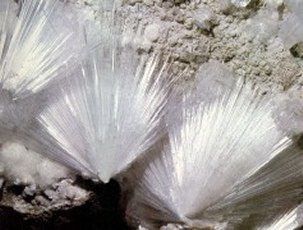 |
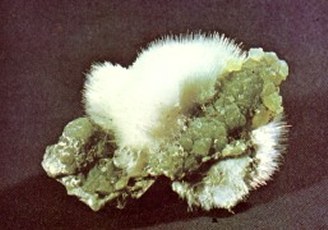 |
| スコレス沸石上に結晶したソーダ沸石 4cm Natrolite crystals overgrown on scolecite Ottens Collection |
針状ソーダ沸石結晶の放射状の集合 長さ 20mm Radiating agregate of natrolite crystals 20mm long |
緑の葡萄石上の放射状のソーダ沸石 Radiating white fibrous natrolite on green botryoidal prehnite |
| Malad Quarry, Kurar, Bombay, India | Ceská Lípa, Czecho Republic | Prospect Park, New Jersey, U.S.A. |
| 沸石族の鉱物 (Zeolite minerals) |
化学組成 (Composition) |
結晶系 (Crystal System) |
結晶形 (Crystal Form) |
結晶構造 Crystal Structure) |
モース硬度 (Hardness) |
比重 (Density) |
屈折率 (Refractive Index) | |
| ソーダ沸石 (Natrolite) |
Na2Al2Si3O10・2H2O | 斜方晶系 (Orthorhombic) |
 |
5 - 5½ | 2.20-26 | 1.473-496 | ||
| 中沸石 (Mesolite) |
Na2Ca2[Al2Si3O10]3・8H2O | 単斜晶系 (Monoclinic) |
5 | 2.30 | 1.525 | |||
| 輝沸石 (Heulandite) |
(Ca,Sr,Na,K)Al2Si7O18・6H2O | 3½ - 4 | 2.1-2 | 1.476-517 | ||||
沸石属鉱物の特徴、名前と産状 (Name, character and Occurence of Zeolite group)
沸石属は珪酸アルミニウム基にナトリウム、カリウム、カルシウム、マグネシウム、バリウム、リチウム等の金属イオンと結合し、さらに水分を含み、表の結晶構造図にあるように内部に無数の小さなトンネルを持ち、微妙に主成分比率と含水率との異なる50種もの一大鉱物グループを成す鉱物です。
沸石族は玄武岩やアルカリ性ペグマタイト、アルプス型熱水鉱床等の空洞中に方解石を伴って生成されます.
ゼオライト (Zeolite) とはギリシア語の " Zeo :沸騰する、と litho :石” の意味に由来する名です。
この名は結晶を加熱すると含まれている水分が吐き出されて沸騰しているように見えることから命名されました。 和名の沸石はその直訳です。
沸石類はその結晶構造と結晶の電荷分布の性質により、イオン交換や脱臭、吸湿、触媒等々広範な作用を持つために広範な産業用途に使われている鉱物でもあります。
Zeolites form well-defined group of minerals closely related to one another in composition, in conditions of formation and mode of occurence. They are all hydrated aluminosilicates, chiefly of sodium and calcium, less commonly pottasium, barium and strontium. The zeolites, however, are not related in crystal structure but comprise a number of independent species, diverse in structure, and distinct in composition.
Zeolites have a frame-work structure enclosing pores occupied by cations and water molecules, both of which have considerble freedome of movement permitting within limits, reversible ion exchange and reversible dehydration. The void created by the loss of water have considerable specific surface area, which permits reversible absorption of molecules small enough to pass the apertures of the channels. Zeolites are, therefore, frequently used forn removing water from other compounds, for example, drying natural gas, and in the petrochmical industry for hydrocarbon removal. They are also used as catalyst supports, providing large surfce areas in chemical rections.
Zeolites minerals occur in hydrothermal in cavities oin volcanic rocks, alkaline pegmatites, along the Alpine-type fissures, also as a product of plagioclase replacement, commonly associated with calcite and zeolites.
The name derives from Greek word "zein : to boil and lithos : a stone", in allusion from the observation upon rapidly heating, a stone start dancing as the water evaporated.
ソーダ沸石 (Sodalite)
ソーダ沸石は沸石族に共通の珪酸アルミニウム分と水分に16.5%の酸化ナトリウムを主成分とする化学組成から、ギリシア語でソーダ (ナトリウム) を意味する ”Natron” と石を意味する ”lithos” から命名された代表的な沸石族の鉱物です。
一般に沸石類の鉱物は針状、柱状、葡萄状、団塊状等の産状で発見されます。
したがって宝石ルースとしてカットできるような充分な大きさの透明な結晶は極めて稀です。
と言うより、これまで見たことも聞いたこともありませんでした。
したがって冒頭の、1.24カラットと小さいながら鋭い切れ味で見事にファセット・カットされた石には大いに驚かされました。
完全な劈開性のためにカットが極めて難しい鉱物でもあります。
苦労してカットしたところで屈折率が低く宝石としての煌きは全く期待できません。
そんなわけで、全く見映えのしないルースではありますが、存在するだけでも貴重な標本には違いありません。
Sodalite is one of the most common mineral in zeolite group with sodium as the major compostion.
In general, zeolite occurs in long prismatic to acicular crystals, fibrous and radil ggregates, grannular, massive. Therefore, transparent crystals with sufficient size, suitable for faceting is extremely rare. The 1.24ct small faceted stone on the top photo was a great surprise, despite dull appearance due to low refractive index and large fissures. This stone should be well appreciated, therefore, as the rarest faceted natrolite, hard to cut due to perfect cleavage.
その他の沸石類(Other zeolites)
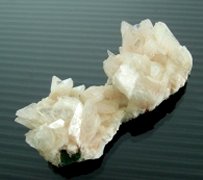 |
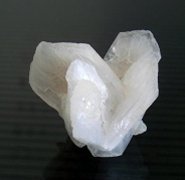 |
 |
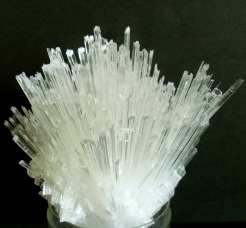 |
| 輝沸石(Heulandite) 60x28x16mm | 輝沸石(Heulandite) 33mm | 魚眼石上の束沸石 35x30mm (Stilbite on apophyllite) |
中沸石(Mesolite) 高さ 9cm |
| Nasik, India | Poona, India | ||
50種類と一大グループを成す沸石類の中で束沸石、輝沸石と中沸石とは前述のソーダ沸石と共に広範に発見される種類です。
ありふれた鉱物ではありますが、美しい姿と多彩な結晶形で楽しませてくれます。
沸石類はその化学組成に発色元素を含まないために無色の結晶が多いのですが、微量の鉄やマンガン等を不純物として含んで淡紅色、淡緑色、淡黄色を示します。
さらにしばしば魚眼石や葡萄石、方解石等の結晶を伴う、絶妙の形と色合いとの組み合わせで産出します。
とりわけインドのボンベイ周辺のデカン高原の玄武岩の無数の晶洞は ”宝石トンネル” と呼ばれるほどの多彩な姿と色合いの鉱物結晶群を内包し、自然の驚異と呼ぶに相応しい光景が展開されます。
世界のペグマタイト鉱床やアメリカ・コロラドや南アフリカのマンガン鉱床も時折宝石質の鉱物結晶群を含む晶洞が発見されますが、たちまちのうちに掘りつくされてしまいます。
一方広大なデカン高原には数限りない玄武岩晶洞がありますから、沸石や魚眼石等は絶えることなく、手頃な値段で供給されます。
Among huge zeolite group minerals, huelandite, stilbite and mesolite are the most common species together with natrolite.
Zeolite minerals are intrinsically colorless, but are colored pale pink, yellow and green with minor metalic impurity of iron and manganese. They are often found in basalt cavities associated with other mineral crystals, forming fantaastic combination of shape and colors. Particularly, numelous basalt pockets in the Deccan plateau, in and near Bombay areas are filled with sparkling crystals of apophyllite, quartz, calcite and varieties of zeolite. Fittingly the crystal wonderland was name the Jewel Tunnel.
Gem pockets are sometimes found from some pegmatite veins and manganese ores in Colorado, U.S.A. and South Africa, but are exhausted soon after the discovery, while numerous Indian basalt pockets have been producing superb mineral crystals since early 20th century.
| Top | Gemhall |